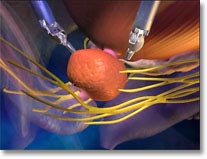Swedish Medical Center has achieved a major breakthrough in medical field by employing a four armed robot to perform prostate surgery. The procedure is called the da Vinci Pros tatectomy.
tatectomy.
The da Vinci Surgical System promises greater precision, less scarring and shorter hospital stay than tradition prostate surgery. Using the new system, instead of making a six to eight inch incision, the removal of the prostate can be done by making just five small incisions of about half an inch long, leading to less pain and faster recovery. This new system provides the surgeon with magnified 3D vision and miniature articulating robotic wristed instrumentation.
The magnified 3D vision is produced by a ‘viewfinder’ which has a special, dual-lens endoscope. It can provide a magnified view, up to 12 times more closely than human vision allows, of the surgical site inside the patient. This is very desirable as it enables surgeons to see small vessels and work more precisely. Besides magnified 3D vision, surgeons are equipped with a robotic computer. The surgeon’s wrists and hands are connected to glove-like sensors and moveme nts are scaled to guide the tools on the robot’s arm, known as EndoWrist®. The flexibility (it can turn 540 degrees) and the motion scaling mechanism of this patented robotic wrist allow greater freedom of movement and finer, more precise movements than standard instruments. For example, if the surgeon’s hand moves five centimeters, he can scale the robotic hands to move only one centimeter. This is particularly important as the nerves associated control the sexual function. On top of the flexibility, this robotic technology provides steadiness by filtering minute tremors of the human hand.
nts are scaled to guide the tools on the robot’s arm, known as EndoWrist®. The flexibility (it can turn 540 degrees) and the motion scaling mechanism of this patented robotic wrist allow greater freedom of movement and finer, more precise movements than standard instruments. For example, if the surgeon’s hand moves five centimeters, he can scale the robotic hands to move only one centimeter. This is particularly important as the nerves associated control the sexual function. On top of the flexibility, this robotic technology provides steadiness by filtering minute tremors of the human hand.
4 comments:
I believe that advances in robotics in surgery is very important as it will contribute to the wider availability as well as a cheaper operation costs. Currently, one of the limiting factors in operations is that a surgeon has to operate personally.
Surgery requires very daft hands, and usually the "life" of a surgeon is limited by how long he can operate comfortable. With new technology such as the one mentioned in the original article, the professional life of these surgeons can be prolonged as robotic hands do not tremble and magnifying actions will lead to more precise control of the knife. Furthermore, simpler operations can be performed by doctors who may not specialise in surgery.
One last point. Remote means that the doctor won't need to move around the different operating theatres and hospital. I think this is excellent as it improves efficiency leading to more patients being operated on per unit time.
Sigh I forgot to add, but I made the post above
Chua Chong Han U045816M
It is actually important forimplementing robotic system on medical aspect. This is because robots usually can perform some difficult task which cannot be done by human easily. Such as the medical robotic system mentioned in this blog, the robot's arm can move precisely and with a very high flexibility. Futhermore, the magnified view function give the surgeon a more detail view on the surgical site.
However, as scaling mechanism is implemented for this robots, will it be difficult for the surgeon to adapt to this scaling and move precisely?
Yong See WEi U048661X
Neurosurgery is always a tricky issue due the delicate nature of the nerves, especially those located deep in the brain or under many layers of damaged tissue. The ability of robotic manipulators to reduce 'minute tremors' would come in very handy for the surgeons.
Two possible advancements along this area:
i) Enabling the manipulators to provide some kind of motion/touch feedback to the surgeon, since surgeon sometimes rely on gut instinct and feel to operate on something obscured from their field of vision
ii) Providing some form of vision system to allow surgeons to see past layers of tissue to narrow down the region of surgery, further reducing damage to nearby tissue. Such systems need to provide vision in real-time and could make use of localised infra-red sensing technology, or even pinhole optical fibres embedded in the manipulators.
by U037779R, Han Mingding
Post a Comment